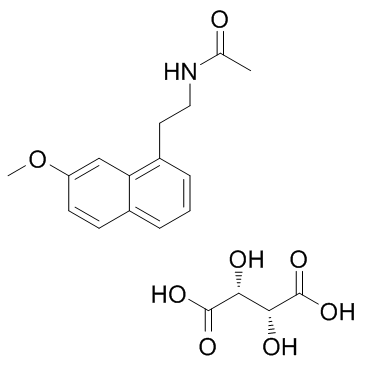Agomelatine L(+)-Tartaric acid
Modify Date: 2024-01-08 06:53:19

Agomelatine L(+)-Tartaric acid structure
|
Common Name | Agomelatine L(+)-Tartaric acid | ||
|---|---|---|---|---|
| CAS Number | 824393-18-2 | Molecular Weight | 393.388 | |
| Density | N/A | Boiling Point | N/A | |
| Molecular Formula | C19H23NO8 | Melting Point | N/A | |
| MSDS | N/A | Flash Point | N/A | |
Use of Agomelatine L(+)-Tartaric acidAgomelatine (L(+)-Tartaric acid) is a antidepressant, which is classified as a norepinephrine-dopamine disinhibitor (NDDI) due to its antagonism of the 5-HT2C receptor. Target: 5-HT 2c receptor Agomelatine L(+)-Tartaric acid is an antidepressant drug. It is classified as a norepinephrine-dopamine disinhibitor (NDDI) due to its antagonism of the 5-HT2C receptor. Activation of 5-HT2C receptors by serotonin inhibits dopamine and norepinephrine release. Antagonism of 5-HT2C results in an enhancement of DA and NE release and activity of frontocortical dopaminergic and adrenergic pathways [1]. A total of 42 rats were divided into 7 groups as each composed of 6 rats: (1) intact, (2) 40 mg/kg agomelatine, (3) 140 mg/kg N-acetylcysteine (NAC), (4) 2 g/kg paracetamol, (5) 2 g/kg paracetamol + 140 mg/kg NAC, (6) 2 g/kg paracetamol + 20 mg/kgagomelatine, and (7) 2 g/kg paracetamol + 40 mg/kg agomelatine groups. Paracetamol-induced hepatotoxicity was applied and liver and blood samples were analyzed histopathologically and biochemically. There were statistically significant increases in the activities of aspartate aminotransferase, alanine aminotransferase, levels of tumor necrosis factor-alpha (TNF-α) and interleukin-6 (IL-6) and 8-iso-prostane, and decreases in the activity of superoxide dismutase and level of glutathione in the group treated with paracetamol. Administration of agomelatine and NAC separately reversed these changes significantly [2].Clinical indications: Depression; Obsessive compulsive disorderFDA Approved Date: October 2011Toxicity: Hyperhidrosis; Abdominal pain; Nausea; Vomiting; Diarrhoea; Constipation; Back pain; Fatigue |
| Name | Agomelatine L(+)-Tartaric acid |
|---|---|
| Synonym | More Synonyms |
| Description | Agomelatine (L(+)-Tartaric acid) is a antidepressant, which is classified as a norepinephrine-dopamine disinhibitor (NDDI) due to its antagonism of the 5-HT2C receptor. Target: 5-HT 2c receptor Agomelatine L(+)-Tartaric acid is an antidepressant drug. It is classified as a norepinephrine-dopamine disinhibitor (NDDI) due to its antagonism of the 5-HT2C receptor. Activation of 5-HT2C receptors by serotonin inhibits dopamine and norepinephrine release. Antagonism of 5-HT2C results in an enhancement of DA and NE release and activity of frontocortical dopaminergic and adrenergic pathways [1]. A total of 42 rats were divided into 7 groups as each composed of 6 rats: (1) intact, (2) 40 mg/kg agomelatine, (3) 140 mg/kg N-acetylcysteine (NAC), (4) 2 g/kg paracetamol, (5) 2 g/kg paracetamol + 140 mg/kg NAC, (6) 2 g/kg paracetamol + 20 mg/kgagomelatine, and (7) 2 g/kg paracetamol + 40 mg/kg agomelatine groups. Paracetamol-induced hepatotoxicity was applied and liver and blood samples were analyzed histopathologically and biochemically. There were statistically significant increases in the activities of aspartate aminotransferase, alanine aminotransferase, levels of tumor necrosis factor-alpha (TNF-α) and interleukin-6 (IL-6) and 8-iso-prostane, and decreases in the activity of superoxide dismutase and level of glutathione in the group treated with paracetamol. Administration of agomelatine and NAC separately reversed these changes significantly [2].Clinical indications: Depression; Obsessive compulsive disorderFDA Approved Date: October 2011Toxicity: Hyperhidrosis; Abdominal pain; Nausea; Vomiting; Diarrhoea; Constipation; Back pain; Fatigue |
|---|---|
| Related Catalog | |
| References |
| Molecular Formula | C19H23NO8 |
|---|---|
| Molecular Weight | 393.388 |
| Exact Mass | 393.142365 |
| (2R,3R)-2,3-Dihydroxysuccinic acid - N-[2-(7-methoxy-1-naphthyl)ethyl]acetamide (1:1) |
| Butanedioic acid, 2,3-dihydroxy-, (2R,3R)-, compd. with N-[2-(7-methoxy-1-naphthalenyl)ethyl]acetamide (1:1) |
| Agomelatine (L(+)-Tartaric acid) |